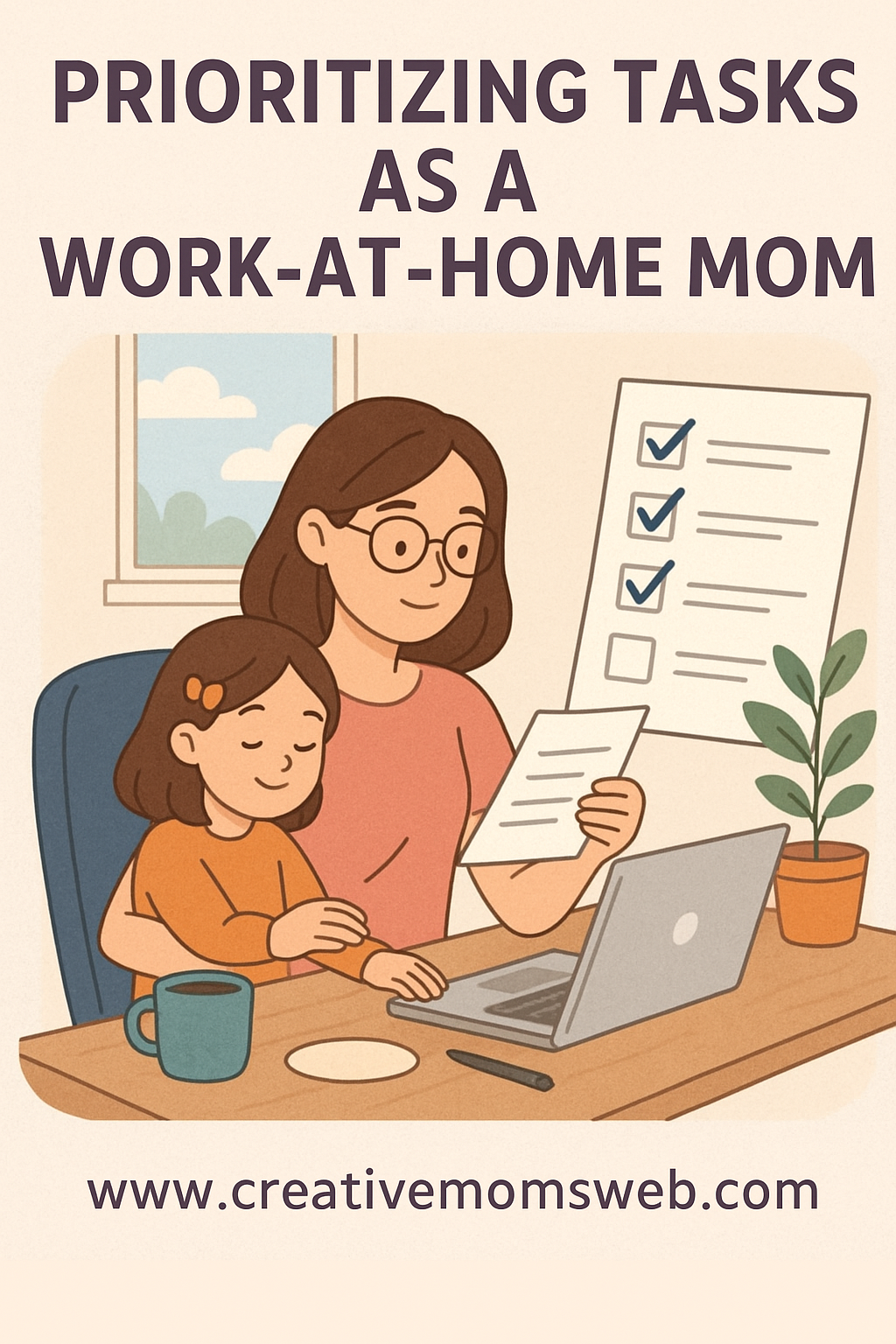Balancing the demands of work and family life from home can be a juggling act for many work-at-home moms. With a multitude of responsibilities both at work and at home, it’s crucial to prioritize tasks effectively to ensure productivity and personal well-being. Here are some strategies to help you manage your time and tasks more efficiently:

Effective Strategies for Prioritizing Tasks as a Work-at-Home Mom
1. Establish a Dedicated Workspace
Create a designated workspace that is separate from your living areas. Having a specific place for work helps you focus and delineates your professional time from your personal time. A well-organized and comfortable workspace can enhance your productivity and reduce distractions.
2. Develop a Structured Routine
Set up a daily routine that accommodates both work and family needs. Start your day with a clear plan of what you need to accomplish. Incorporate work hours, breaks, family time, and household responsibilities into your schedule. A structured routine helps you stay on track and manage your time effectively.
3. Prioritize Tasks Using the ABC Method
The ABC method is a simple yet effective way to prioritize tasks:
- A Tasks: High-priority tasks that are critical and need immediate attention.
- B Tasks: Important but less urgent tasks that contribute to your long-term goals.
- C Tasks: Tasks that are less important and can be postponed or delegated.
By categorizing tasks, you can focus on what’s most important and tackle high-priority items first.
4. Utilize Time Blocking
Time blocking involves allocating specific periods of time to different tasks or activities. Schedule blocks for work tasks, meetings, family time, and household chores. This method helps you manage your time efficiently and ensures that each area of your life receives appropriate attention.
Assign chunks of time to specific activities:
- 6:30–8:00 AM: Morning routine and breakfast
- 8:00–10:00 AM: Work/blogging time
- 10:00–11:00 AM: House chores/laundry
- 11:00–1:00 PM: Client calls or content creation
- 1:00–2:00 PM: Lunch and rest
- 2:00–4:00 PM: Kids’ homework/help
- 4:00–6:00 PM: Cooking/dinner prep
- 7:00 PM onward: Wind down and self-care
This structure helps minimize distractions and ensures you make time for both work and family.
5. Leverage Technology and Tools
Use productivity tools and apps to stay organized and manage your tasks. Tools like digital calendars, project management software, and task lists can help you track deadlines, set reminders, and stay on top of your responsibilities. Automation tools can also streamline repetitive tasks and save you time.
6. Set Clear Boundaries
Establish boundaries between work and personal life to prevent overlap and burnout. Communicate your working hours to your family and set clear expectations about when you are available for work and when you are not. Similarly, try to disconnect from work during family time to ensure you fully engage with your loved ones.
7. Delegate and Outsource
You don’t have to do everything yourself. Delegation and outsourcing can help manage your workload more effectively:
Outsource Work Tasks: Consider outsourcing tasks such as administrative work, cleaning, or grocery shopping to free up your time.
Delegate Family Tasks: Involve family members in household chores and responsibilities. Read age-appropriate chores
8. Practice the Pomodoro Technique
The Pomodoro Technique involves working in focused intervals, typically 25 minutes, followed by a short break. After completing a few intervals, take a longer break. This technique helps improve concentration and productivity while preventing burnout. It can be especially useful when balancing work tasks with household responsibilities.
9. Review and Adjust Regularly
Regularly review your task list and priorities to ensure you’re staying on track. Assess what’s working well and what might need adjustment. Flexibility is key, as priorities can shift due to changes in work demands or family needs. Make adjustments as necessary to stay productive and maintain balance.
10. Prioritize Self-Care
Taking care of yourself is essential for maintaining productivity and overall well-being. Schedule time for self-care activities, such as exercise, hobbies, or relaxation. Self-care helps you recharge and stay motivated, allowing you to handle work and family responsibilities more effectively.
11. Identify Your Top Priorities
Start by determining what truly matters in your daily life. Break down your responsibilities into categories such as work tasks, family obligations, personal goals, and self-care. Use these categories to identify your top priorities:
- Work Tasks: What are the most critical tasks for your job? Focus on high-impact activities that drive your career forward.
- Family Obligations: Prioritize family commitments like school activities, meals, and quality time.
- Personal Goals: Consider your own aspirations, such as exercise, hobbies, or personal projects.
- Self-Care: Ensure you allocate time for relaxation and self-care to recharge and avoid burnout.
12. Use the Eisenhower Matrix
The Eisenhower Matrix is a popular tool for task prioritization. It categorizes tasks into four quadrants:
- Urgent and Important: Tasks that need immediate attention and are critical to your goals. Handle these tasks first.
- Important but Not Urgent: Tasks that are important for your long-term goals but do not require immediate action. Schedule these tasks to ensure they get done.
- Urgent but Not Important: Tasks that require immediate attention but do not contribute significantly to your long-term goals. Delegate or minimize these tasks.
- Not Urgent and Not Important: Tasks that neither impact your immediate needs nor long-term goals. Consider eliminating or postponing these tasks.
13. Implement the 80/20 Rule
The 80/20 Rule, also known as the Pareto Principle, suggests that 80% of your results come from 20% of your efforts. Focus on the tasks that have the most significant impact on your goals.
- Identify High-Impact Tasks: Determine which tasks yield the highest returns and prioritize them.
- Minimize Low-Impact Tasks: Reduce time spent on activities that contribute minimally to your objectives.
14. Break Tasks into Manageable Steps
Large tasks can feel overwhelming and lead to procrastination. Break them into smaller, manageable steps to make them less daunting:
- Create a Task List: List out all the steps needed to complete a larger project.
- Set Milestones: Establish deadlines for each step to maintain momentum and track progress.
- Celebrate Progress: Acknowledge and reward yourself for completing milestones to stay motivated.
15. Practice Saying No
Overcommitting can lead to burnout and decreased productivity. Learn to say no to tasks or activities that do not align with your priorities or that could overwhelm your schedule:
- Assess Your Capacity: Before agreeing to new commitments, evaluate your current workload and available time.
- Set Boundaries: Clearly communicate your limits and prioritize your existing responsibilities.
16. Match Tasks with Energy Levels
We all have energy highs and lows during the day. Schedule demanding tasks like writing, meetings, or data analysis during your peak energy hours (often mid-morning). Save lighter tasks—like folding laundry or replying to emails—for your low-energy windows.
This way, you’ll feel less drained and more efficient.
Here are some Amazon essentials you can add to your blog post “Prioritizing Tasks as a Work-at-Home Mom” to help your readers stay organized and productive:
Amazon Essentials for Prioritizing Tasks as a Work-at-Home Mom
1. Daily Planner or Productivity Journal
A physical planner is perfect for brain dumps, daily top 3 tasks, and time blocking.
Recommended:
2. Dry Erase Weekly Calendar Board
Helps you visually time-block and plan out your week. Great for tracking family schedules too.
Recommended:
3. Desk Organizer with Notepads & Sticky Notes
Keeps your task lists, sticky reminders, and pens neatly organized so your workspace stays clutter-free.
Recommended:
4. Timer or Pomodoro Timer
Use it for focused work sessions (e.g., 25-minute Pomodoro technique blocks).
Recommended:
5. Noise-Canceling Headphones
Block out distractions during work hours while kids are home.
Recommended:
6. Ergonomic Home Office Supplies
Comfort helps improve focus. Consider a good chair or a standing desk converter.
Recommended:
7. Weekly Meal Planner Pad
Reduces decision fatigue—plan meals in advance so you have more mental space for work.
Recommended:
8. Family Command Center Supplies
Set up a space where the whole family knows the plan—reduces interruptions and forgotten tasks.
Recommended:
By implementing these strategies, work-at-home moms can better manage their time and tasks, leading to increased productivity and a more balanced lifestyle. It’s about finding the right mix that works for you and adapting as needed to handle the dynamic nature of work and family life.

